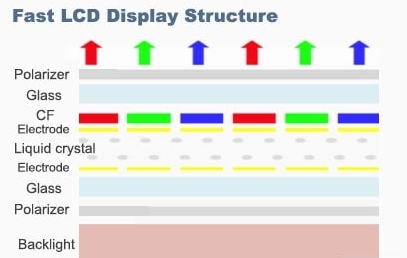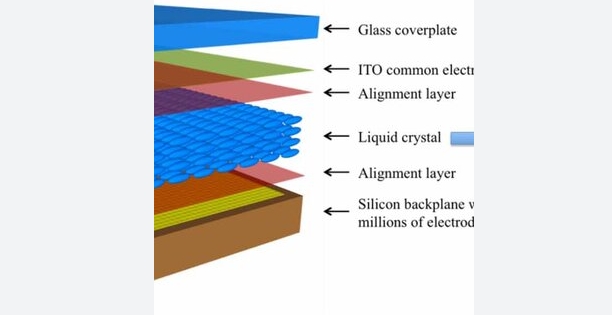




2025-03-13
In today's era of rapid technological development, microdisplay technology is constantly innovating, bringing new opportunities and changes to numerous fields.
At present, the core microdisplay technologies mainly cover Micro-OLED on silicon, Micro-LED, Fast-LCD, LCOS, and AMOLED.
Among them, silicon-based Micro-OLED has become a display solution with great potential in the field of microdisplays. Next, this article will explain in detail the top 5 global microdisplay mainstream technologies and applications in 2025.

Micro-OLED uses a single-crystal silicon semiconductor as the substrate, integrating tens of millions of transistors to form a CMOS driving circuit. OLED organic materials are evaporated on the CMOS driving circuit to form light-emitting diodes, which are microdisplay devices with high resolution and small size.
Micro-OLED microdisplays are divided into passive and active types according to the driving mode, and into glass substrates, silicon substrates, and flexible substrates according to different substrates.
Due to the differences in the PPI pixel circuits, silicon substrates are generally selected for Micro-OLED displays of small size. Their characteristics are: self-luminous, thin in thickness, light in weight, large viewing angle, short response time, high luminous efficiency, and the PPI pixel density can reach more than 3000 PPI.
These characteristics make Micro-OLED microdisplays very suitable for applications in VR, electronic sights, and night vision devices. Silicon-based micro OLEDs integrate electronics, optics, materials and semiconductor technologies, and are strongly supported by policies of various countries. In the future, Micro-OLED on silicon will occupy an important position in the field of microdisplays.

MOT was established in Hong Kong in 2020 and is a modern enterprise integrating research, development, production, and sales in the field of high-resolution near-eye displays. Currently, MOT has grown into a leading enterprise in the global silicon-based OLED industry.
MOT's core technology research and development team is composed of 5 senior doctors in microelectronics and optoelectronics who graduated from top universities in the United States.
More than 60 top technologies developed by MOT have applied for US patents, among which the technical patents of FSL have achieved disruptive breakthroughs in the industry.
Cooperation Contact: https://www.micro-oledtech.com/contact/
More Manufacturers: Top 10 Micro OLED Display Manufacturers in the World in 2025
The traditional LCD (Liquid Crystal Display) technology places liquid crystals between two glass substrates. The lower glass substrate is equipped with a TFT (Thin Film Transistor), and the upper glass substrate is equipped with a color filter.
By means of the changes in signals and voltages on the TFT, the rotation direction of the liquid crystal molecules is controlled, and then the polarized light of the pixel points is controlled to emit to display images.

Fast-LCD is a liquid crystal display technology developed based on traditional LCD. The molecular response speed has been greatly improved, with higher photoelectric response speed and better optical performance, and a high refresh rate. Compared with traditional LCD, the response speed of Fast-LCD is shortened to 1 ms, and the picture transition is more natural.
In terms of resolution and color depth, Fast-LCD can easily achieve a resolution of 4K or even 8K, and the color depth can reach 10 bits.
LCOS is a reflective display technology that combines LCD and CMOS integrated circuits. A driving panel is fabricated using semiconductor technology on a silicon wafer. After being flattened by a grinding device, aluminum is plated to form a reflector to make a CMOS substrate. Then the CMOS substrate is bonded to a glass substrate, liquid crystals are injected and packaged.
LCOS has a very high resolution. Taking Google Glass as an example, the use of LCOS technology provides a very high-resolution display and is more power-efficient. Compared with LCD and DLP, the light utilization efficiency of LCOS can reach more than 40%, while that of LCD is only 10%.

Moreover, the LCOS screen is small in size, and its resolution is higher than that of transmissive LCD. In terms of the manufacturing process, the LCOS manufacturing technology is mature, and the yield rate of the front-end semiconductor CMOS manufacturing can reach more than 90%, with low cost. Microsoft HoloLens also uses LCOS technology.
AMOLED screens are extremely thin and light, and a touch layer can be integrated into the screen, which makes them widely used in watches, mobile phones, PADs, and laptops. For example, in the smartwatch market, many brands use AMOLED screens, making the products thinner and lighter.
Secondly, high-resolution AMOLEDs use the pentile arrangement to greatly emphasize green, making the screen image contrast higher. Taking the Samsung Galaxy series of mobile phones as an example, their AMOLED screens have very good color and high-contrast images.

Samsung Galaxy S series: It uses Super AMOLED screens, presenting deep blacks and vivid colors. The Galaxy S23 series has a refresh rate of 120Hz.
Huawei P series and Mate series: Huawei's high-end models also use a large number of AMOLED screens, such as the Huawei Mate 60 series.
Lenovo Yoga Tab 13: It uses a flexible AMOLED screen with a bendable design.
Asus ZenBook 17 Fold OLED: This foldable laptop uses an AMOLED screen, which provides a larger display area when unfolded.
OPPO Watch: It is equipped with a 1.91-inch flexible AMOLED screen, which can better fit the curve of the wrist.
LG Signature OLED TV R: The world's first rollable OLED TV uses a flexible AMOLED panel that can be automatically rolled up or unrolled.
Virtual Reality (VR) and Augmented Reality (AR) devices: For example, the HTC Vive Pro 2 uses an AMOLED screen.
For Micro-LED microdisplays, a CMOS circuit is used as the underlying driving backplane. A micro LED array is formed by semiconductor processes on a GaN epitaxial wafer. Then the epitaxial wafer and the driving backplane wafer are bonded at the wafer level to form an electrical connection, and then a monolithic full-color display is formed using quantum dot technology.
Each pixel of Micro-LED is composed of red, green, and blue sub-pixels, and each sub-pixel can precisely control the brightness. The PPI of Micro-LED displays can be as high as 10,000 nits, the contrast ratio reaches 1,000,000:1, and the color gamut is wide, with a coverage range of up to 100% DCI-P3.
However, the chip transfer technology of Micro-LED is still not mature enough, which is still a problem that the industry urgently needs to solve. In terms of cost control, the manufacturing process of Micro-LED is complex, and the product cost remains high.
According to TrendForce's "2024 Micro LED Market Trends and Technology Cost Analysis Report", with the progress of AI-assisted tools, the demand for AR glasses using Micro-LED will expand rapidly within the next 1 to 2 years.
On December 19, 2024, China's first TFT-based Micro-LED mass production line started mass production. Hisense also revealed that it will release 163-inch and 136-inch Micro-LED TVs during AWE. Previously, from April 17 to 19, 2024, at the InfoComm China 2024 exhibition, Xuxian Future launched the world's first true Micro-LED thin film chip MiP direct display 4K large screen. On December 29 of the same year, the world's first Micro 4K LED movie screen was installed in a cinema in Shijiazhuang, Hebei.
In terms of in-vehicle display, Shenzhen Tianma A currently has a layout of Micro-LED business for in-vehicle display applications. Moreover, Micro-LED can also be used in augmented reality and panoramic head-up displays (AR-HUD and P-HUD), as well as transparent display technology for car windows. More Application Cases: The 11 most important applications of silicon-based Micro OLED display technology in 2025